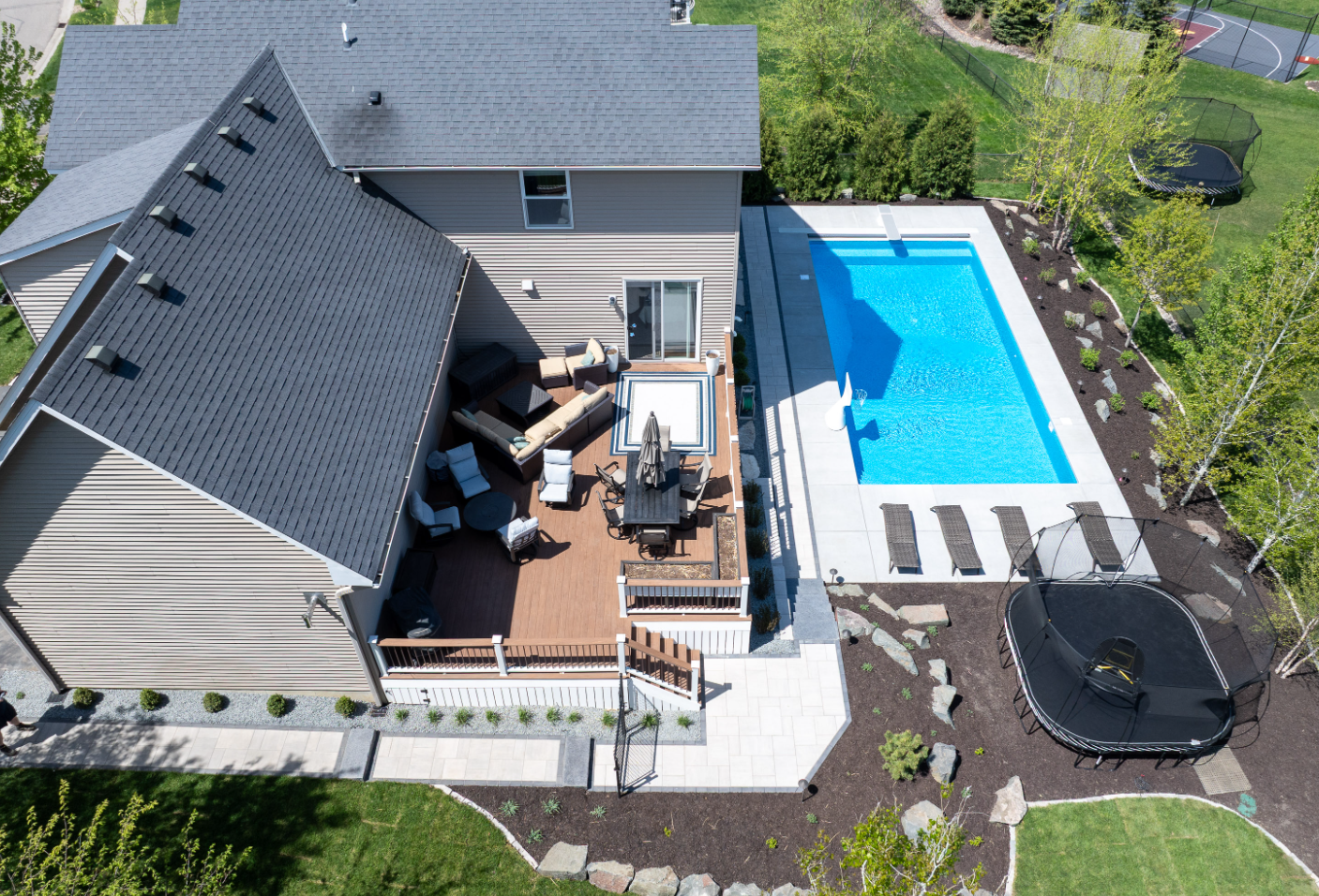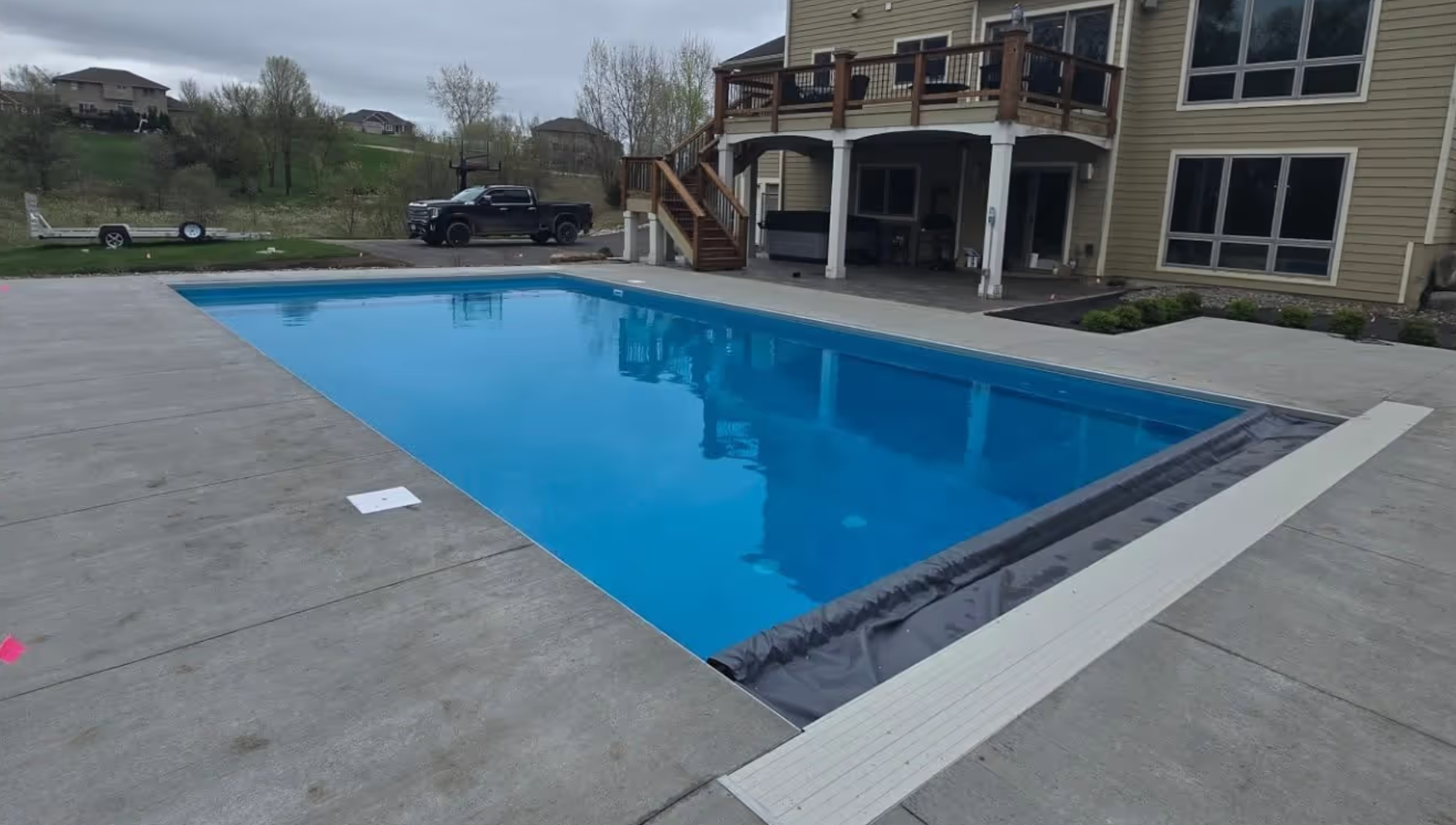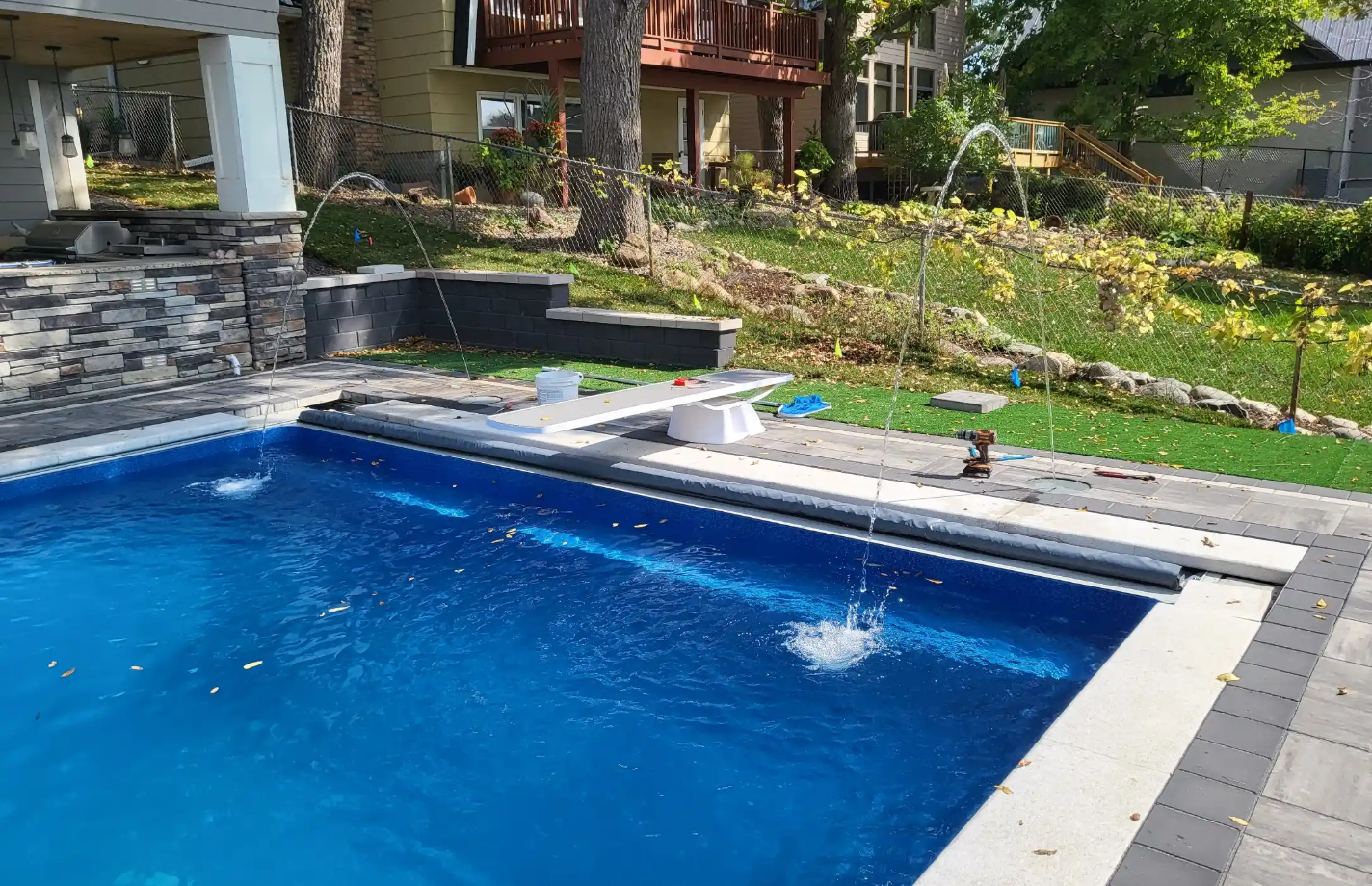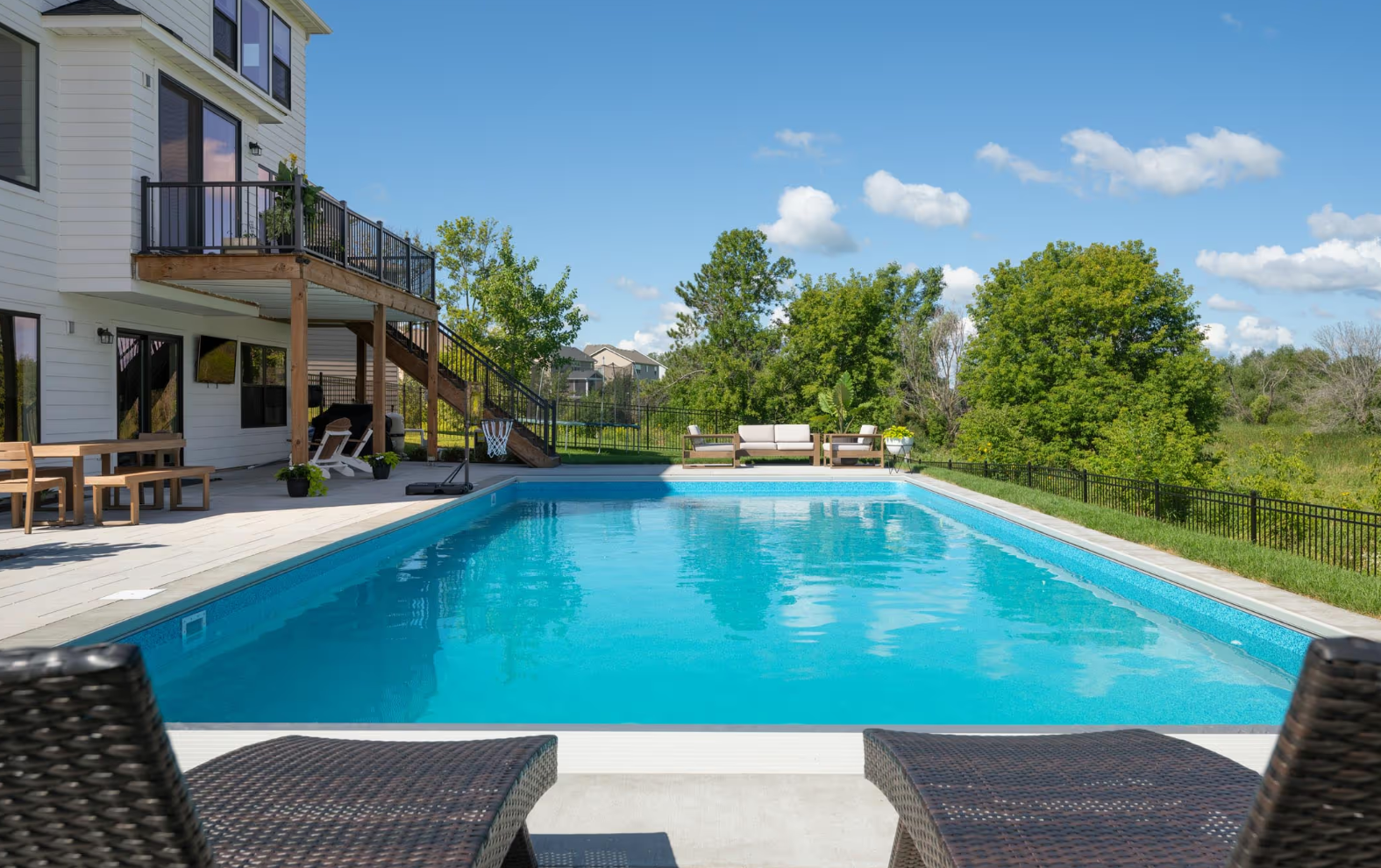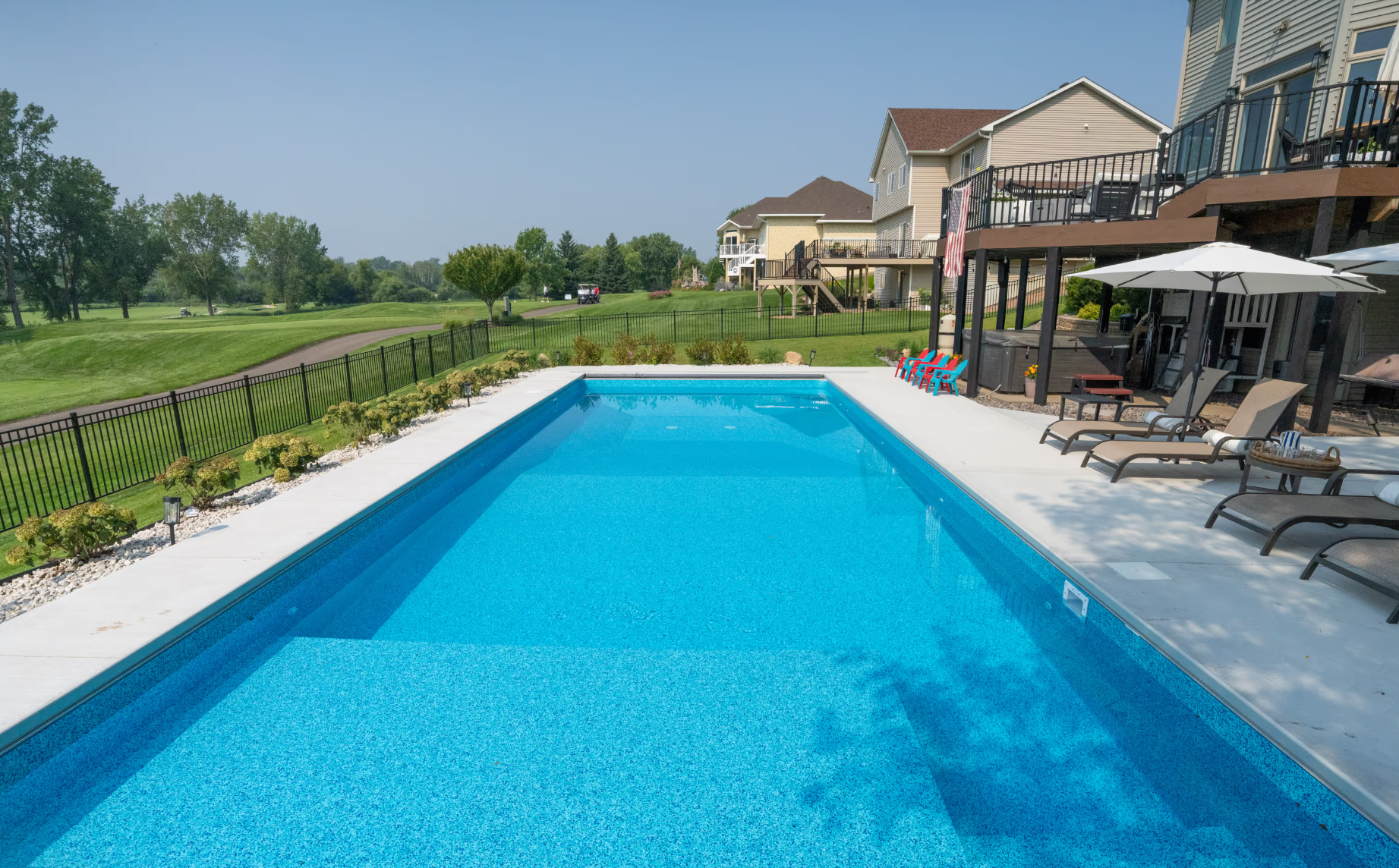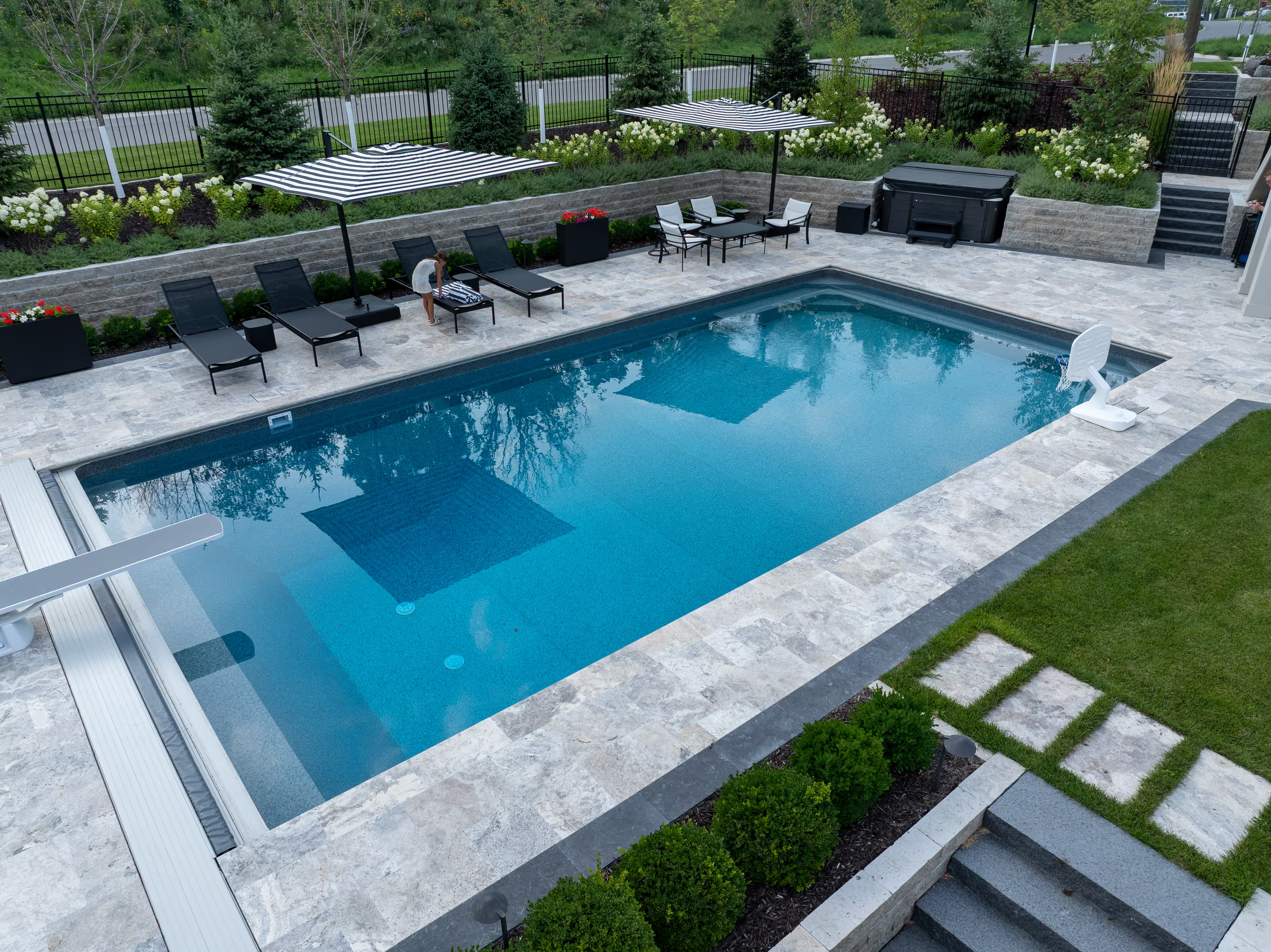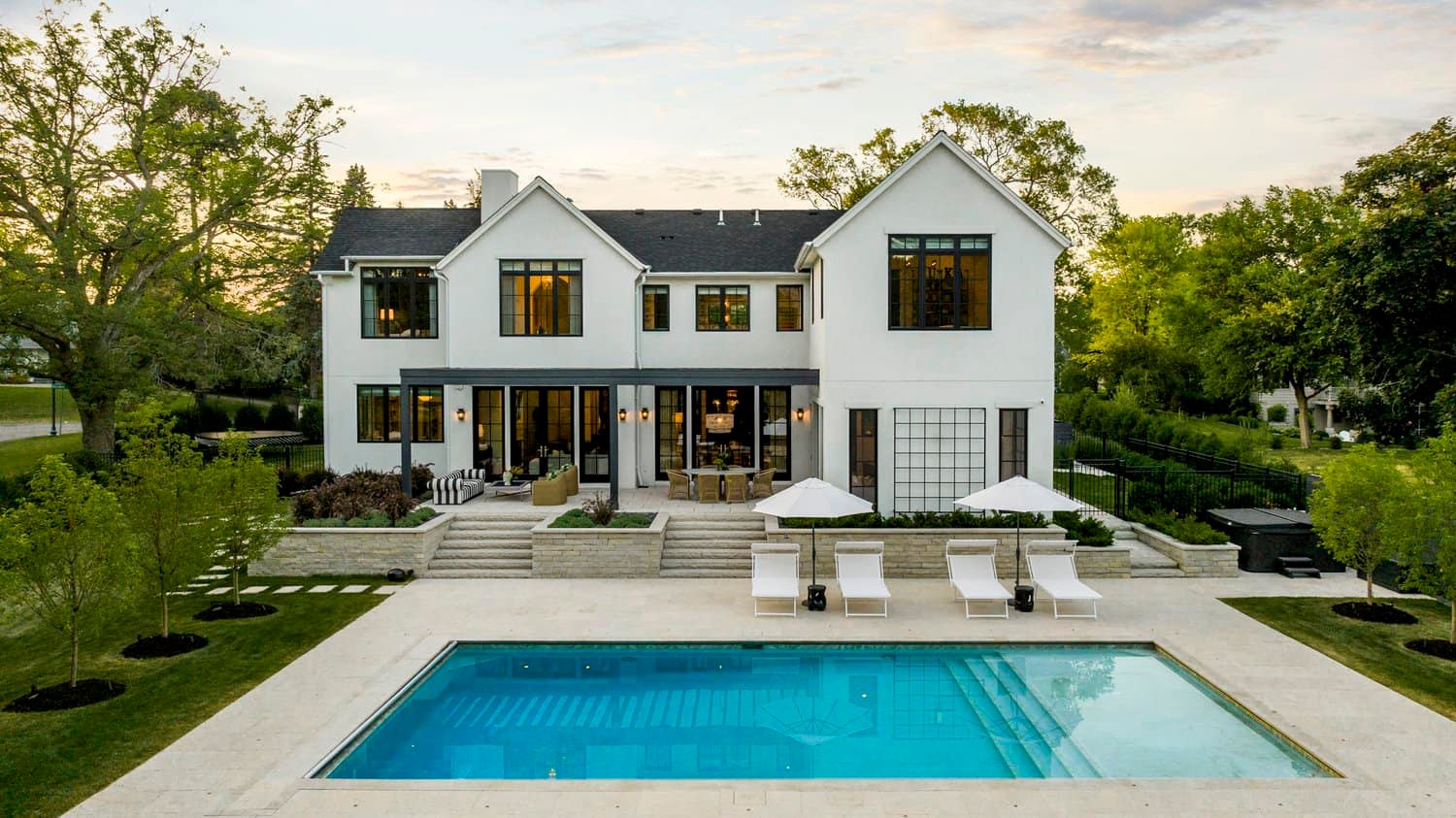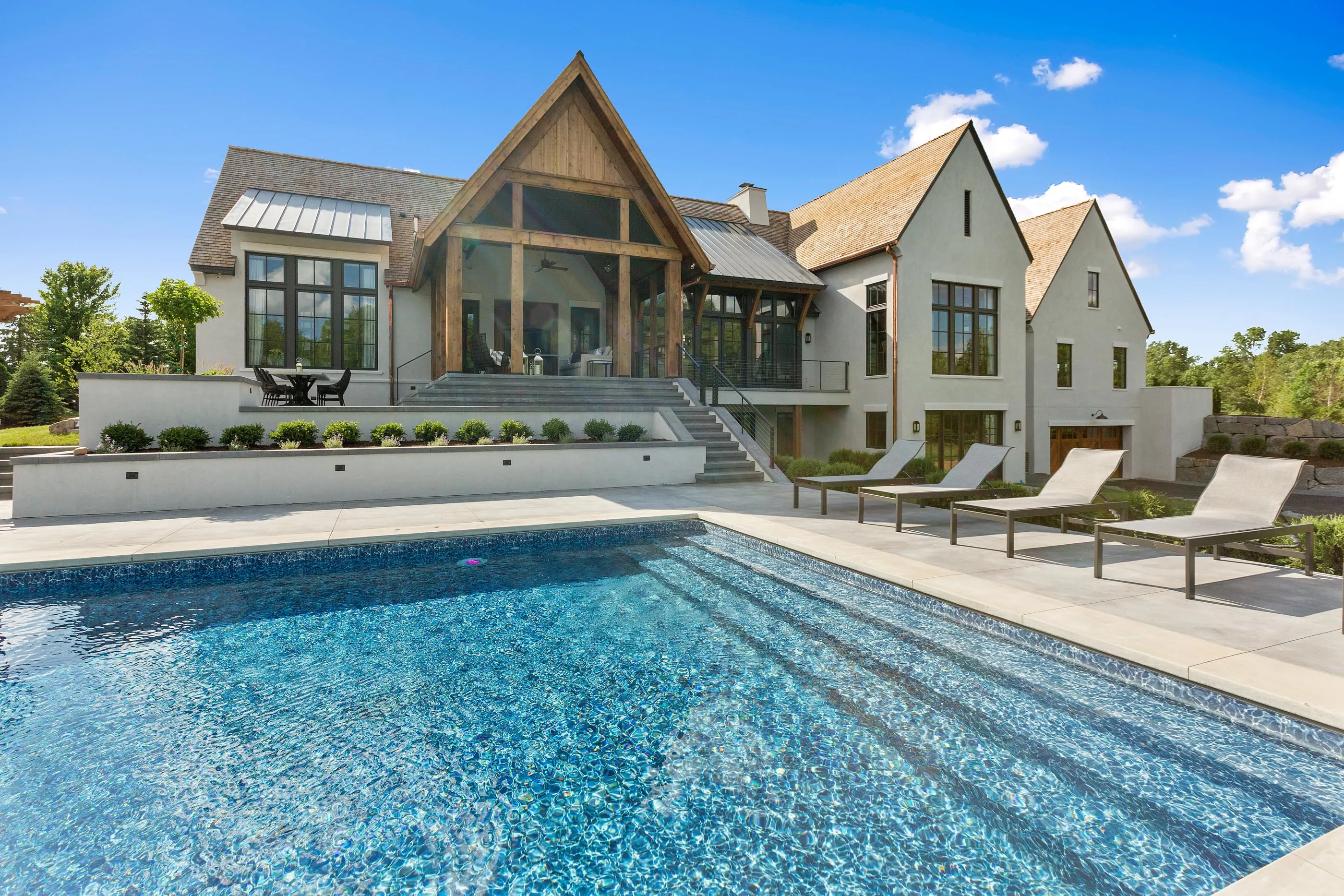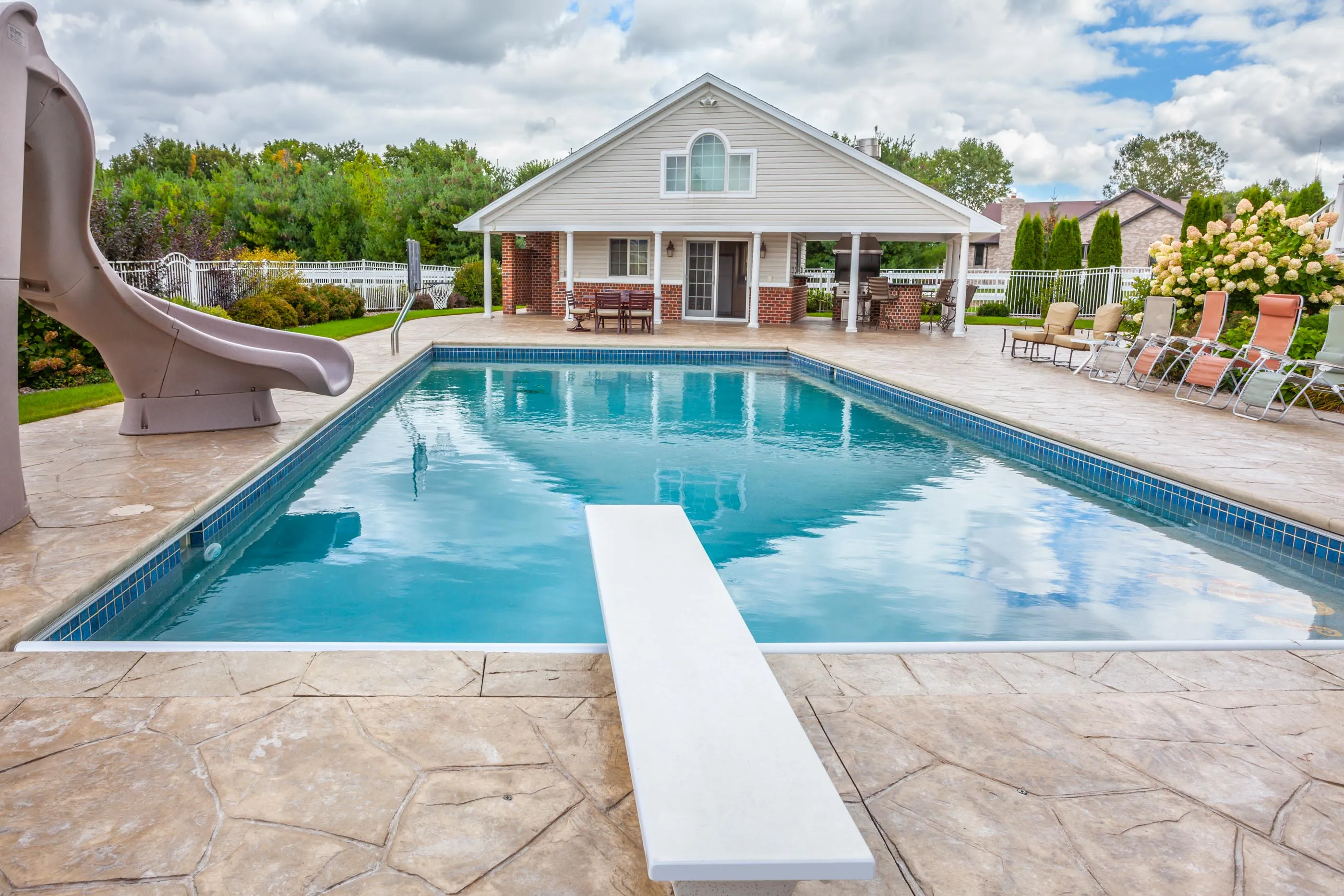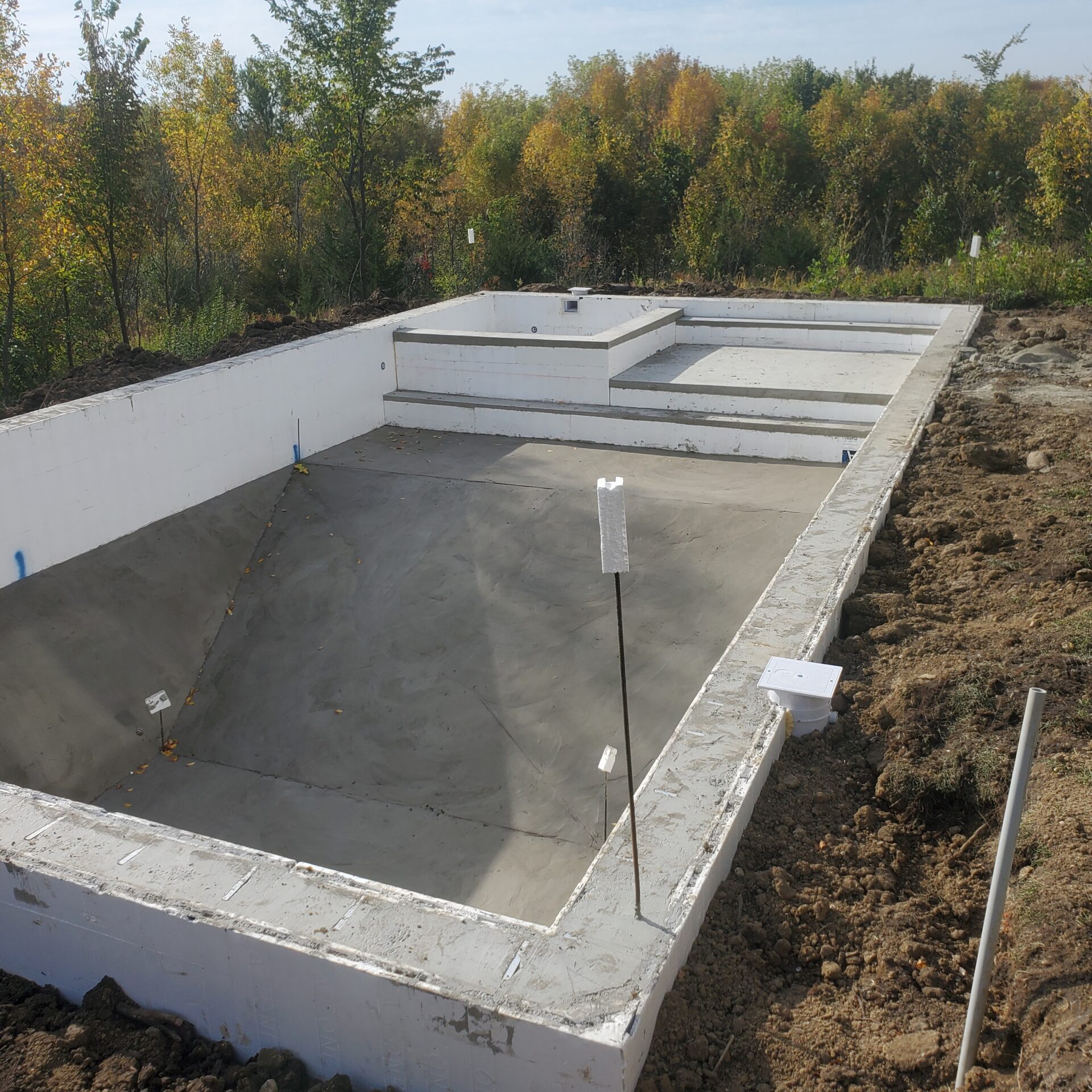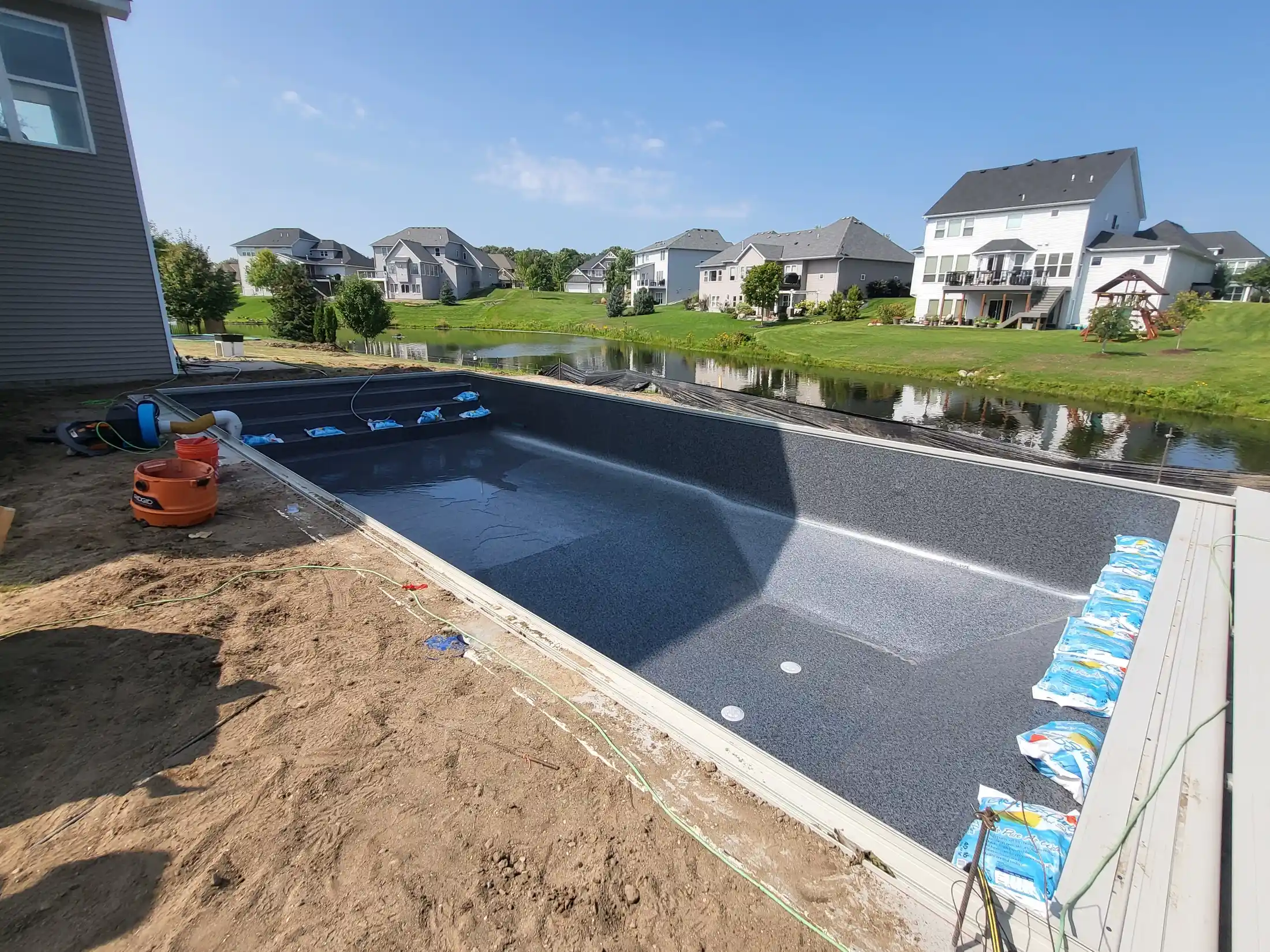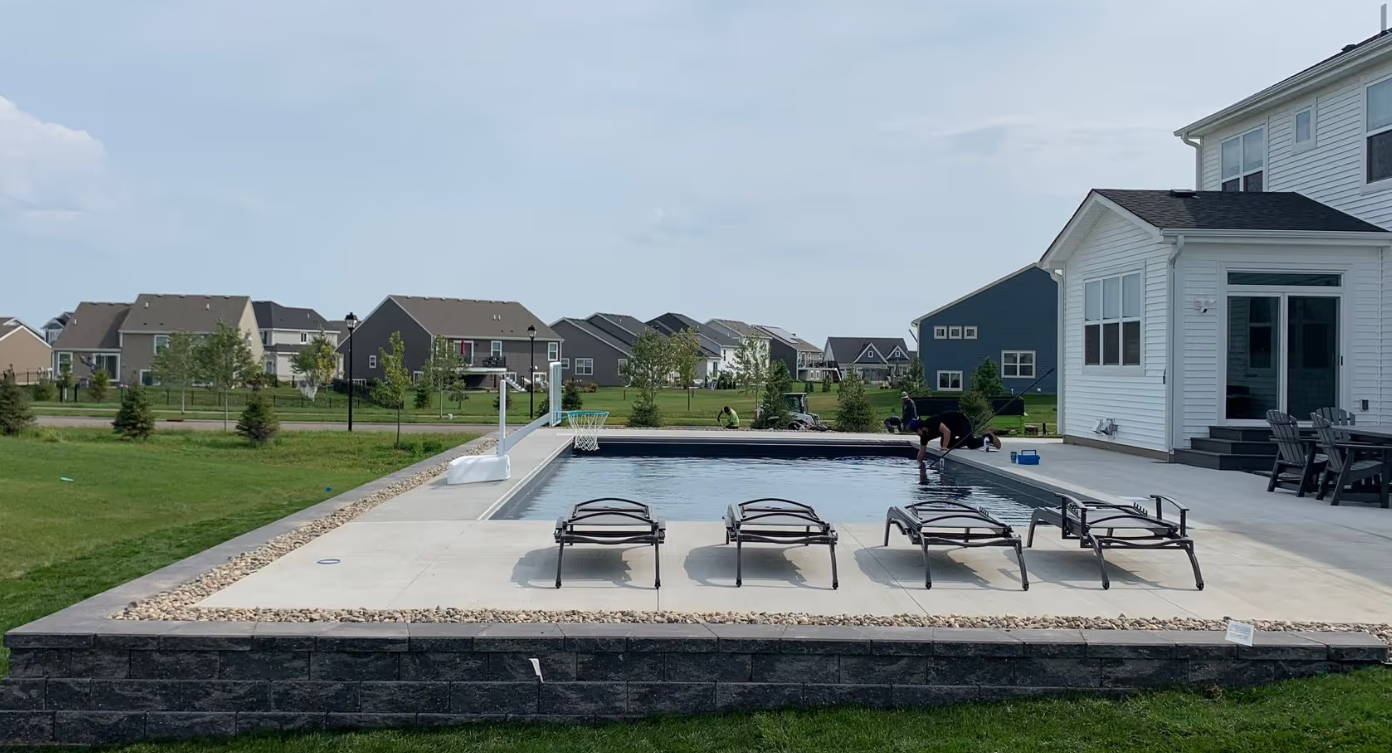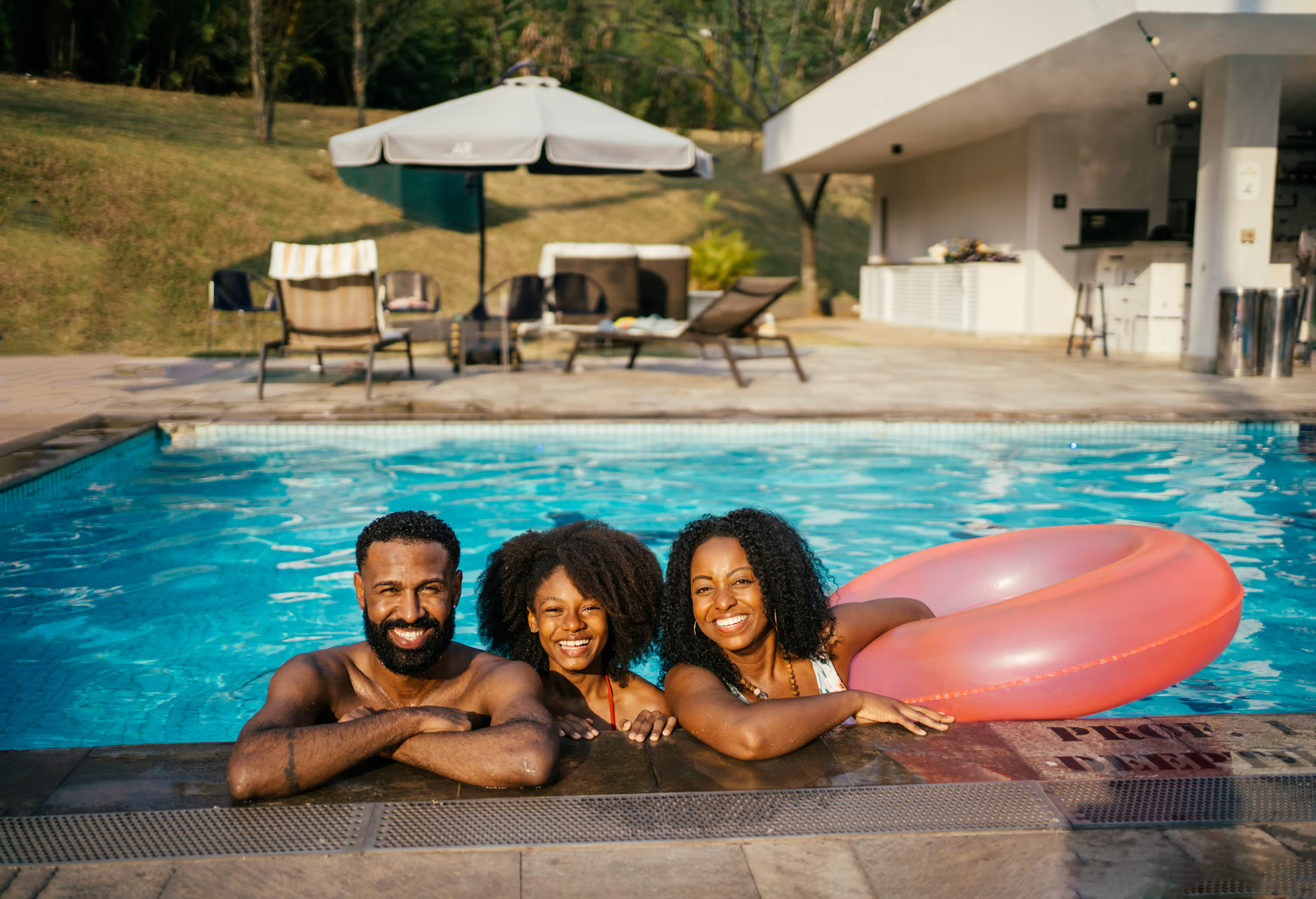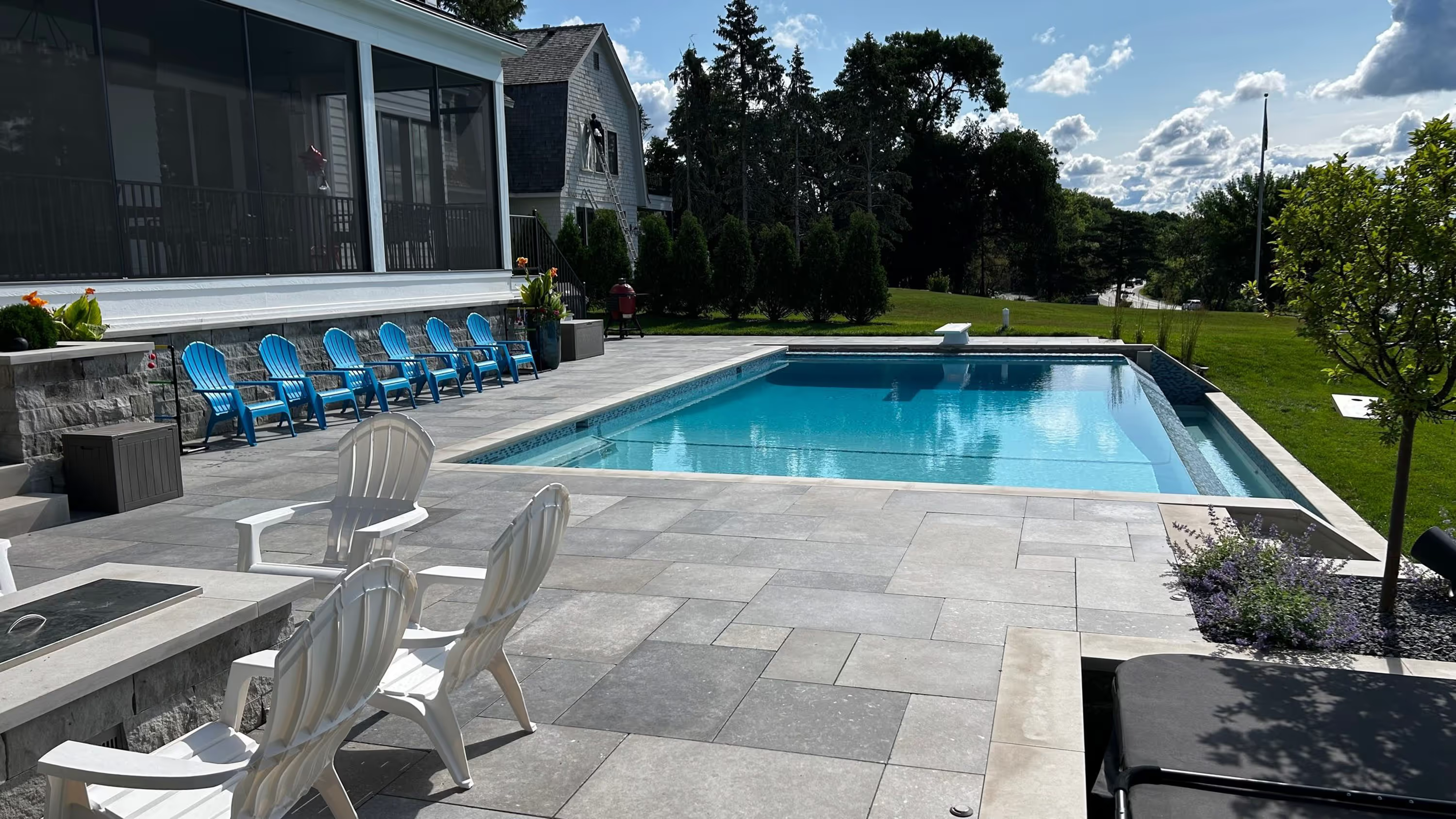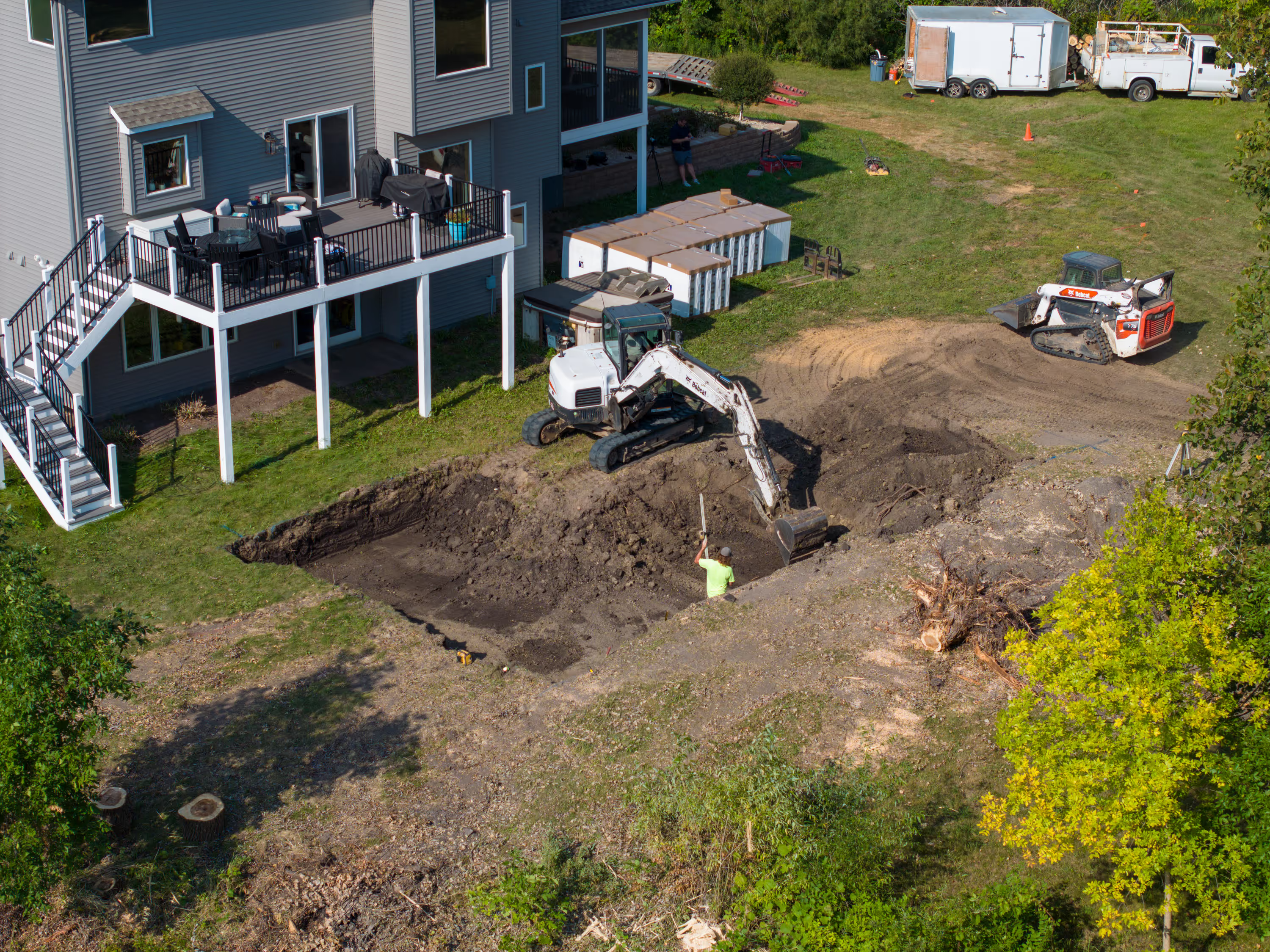Thinking about building a backyard swimming pool in Minnesota? You're not alone. Every spring, thousands of Twin Cities homeowners start dreaming about transforming their backyards into private resort-style retreats. But before you break ground, you need to understand both the incredible benefits and the real challenges of pool ownership in our unique Minnesota climate.
The truth is, building an inground swimming pool is one of the biggest investments you'll make in your home—typically ranging from $90,000 to $150,000+ for a quality installation. That's a significant financial commitment, and you deserve to know exactly what you're getting into before you sign any contracts.
This comprehensive guide will walk you through everything you need to know: the genuine advantages that make pools worth every penny, the potential drawbacks you should prepare for, and the Minnesota-specific considerations that can make or break your pool ownership experience.
Why Minnesota Families Are Building Pools
Before we dive into the detailed pros and cons, let's understand why pool construction has surged in Minnesota over the past decade. According to industry data, the Twin Cities metro area has seen a 40% increase in residential pool installations since 2015.
What's driving this trend?
- Changing vacation patterns: Families are investing in "staycation" amenities rather than expensive annual trips
- Remote work flexibility: More time at home means more value from home improvements
- Health and wellness focus: Families prioritize physical activity and outdoor time
- Property value enhancement: Quality pools add significant resale value in desirable markets
- Community isolation during recent years: Homeowners want private recreation spaces
But trends alone don't determine whether a pool is right for your family. Let's examine the specific advantages and challenges so you can make an informed decision.
The Major Advantages of Minnesota Pool Ownership
1. Your Own Private Resort (50+ Steps from Your Door)
The biggest advantage of pool ownership is accessibility. Unlike public pools, lake cabins, or water parks that require travel and coordination, your backyard pool is literally steps away from your kitchen.
This accessibility fundamentally changes how you experience summer:
- Spontaneous enjoyment: After-work swims, quick cooldowns during heat waves, or impromptu family pool time without any planning
- No wasted time: Zero travel, no packing the car, no waiting in lines
- Use it whenever you want: Early morning laps, evening relaxation, or weekend pool parties—your schedule, your rules
- Weather flexibility: Brief sunny window between storms? Take advantage immediately
Plan Pools customers report using their pools 50-100+ times per season, compared to visiting public pools or lakes only 5-10 times annually when travel and coordination were required.
2. Exceptional Physical Fitness and Health Benefits
Swimming is one of the most effective forms of exercise available, offering:
- Low-impact cardio: Perfect for all ages and fitness levels, especially those with joint issues
- Full-body workout: Engages virtually every muscle group simultaneously
- Calorie burning: Swimming burns 400-700 calories per hour depending on intensity
- Stress reduction: Water-based exercise reduces cortisol levels and promotes relaxation
- Flexibility and range of motion: Water resistance builds strength while supporting joints
For Minnesota families, having a pool means physical activity becomes a natural, enjoyable part of daily life rather than a chore requiring gym memberships or structured exercise programs.
The family health impact is significant: Studies show that families with backyard pools engage in 60% more physical activity during summer months compared to families without pools. Children with pool access are more likely to develop swimming proficiency and lifelong fitness habits.
3. The Ultimate Family Gathering Place
A backyard pool transforms your home's social dynamics in profound ways:
For immediate family:
- Natural gathering point that draws family members outdoors
- Creates daily opportunities for conversation and connection
- Reduces screen time as outdoor activity becomes more appealing
- Provides shared experiences that strengthen family bonds
For extended family and friends:
- Your home becomes the default gathering location for celebrations, holidays, and casual get-togethers
- Hosting becomes effortless when the entertainment is built-in
- Creates multi-generational spaces where everyone from toddlers to grandparents can participate
- Builds lasting memories in a consistent, familiar setting
As one Lakeville customer told us: "Our pool has completely changed how our family spends time together. Instead of everyone scattered in different rooms on devices, we're outside together almost every evening. It's been transformative."
4. Significant Property Value Enhancement
A professionally installed, well-maintained inground swimming pool adds substantial value to your property, particularly in family-friendly neighborhoods where outdoor amenities are highly desirable.
Real estate data shows:
- 5-10% home value increase in desirable markets with strong school districts
- Competitive advantage when selling—your home stands out in listings
- Faster sales in markets where pools are desirable but not ubiquitous
- Appeal to specific buyer demographics: Families with children, empty nesters, and active adults
Important note: Property value enhancement depends heavily on quality installation. Cheaply built pools with ongoing maintenance issues can actually hurt resale value. This is why working with an experienced contractor like Plan Pools who uses superior ICF construction methods is crucial for long-term value.
5. Extended Outdoor Living Season
Minnesota's outdoor season is precious but limited. A well-designed pool dramatically extends your ability to enjoy your backyard:
Traditional outdoor season: Late May through early September (14-16 weeks)
Pool season with ICF construction: Early May through late September (18-20 weeks)
The superior insulation of ICF (Insulated Concrete Form) pools maintains comfortable water temperatures with dramatically lower heating costs, allowing you to:
- Open your pool 2-3 weeks earlier in spring
- Keep your pool open 2-3 weeks later in fall
- Enjoy comfortable water temperatures even during cooler Minnesota evenings
- Use your pool on cooler days when lakes would be too cold
This represents a 25-30% longer usable season compared to traditional pools or lake swimming.
6. Cost-Effective Compared to Alternative Recreation
When analyzed over time, pool ownership becomes remarkably cost-effective compared to alternatives:
Annual costs for family recreation alternatives:
- Lake cabin rental: $8,000-$15,000+ per season
- Water park season passes for family of four: $1,200-$2,000
- Community pool memberships: $800-$1,500
- Boat ownership: $9,000-$12,000 annually (storage, fuel, insurance, maintenance)
- Destination vacations: $5,000-$15,000+ per trip
Annual operating costs for quality pool:
- $1,500-$3,000 (heating, chemicals, electricity, maintenance)
Cost per use over a season:
- Pool (used 75 times): $20-40 per use
- Lake cabin (used 10 weekends): $800-$1,500 per use
- Water park (used 15 times): $80-$130 per use
The pool delivers exceptional value when measured by actual usage frequency.
7. Complete Control Over Water Quality and Safety
Unlike public pools or lakes, your backyard pool gives you complete control over:
Water quality:
- Chlorine or salt system levels precisely managed
- Regular testing and adjustment to optimal levels
- No concerns about overcrowding, contamination, or inconsistent maintenance
- Modern salt water systems provide gentle, effective sanitization without harsh chemical smells
Safety environment:
- You set and enforce all safety rules
- Modern automated safety covers provide superior protection when pool is not in use
- Controlled depth appropriate for your family's needs
- No concerns about unknown hazards, currents, or other swimmers' behavior
Privacy:
- No crowds, no lines, no reserving spaces
- Use your pool however you want—swimming laps, floating leisurely, or playing games
- Accommodate special needs without public scrutiny
8. Customization to Your Exact Preferences
A custom inground pool can be designed to perfectly match your:
Aesthetic preferences:
- Pool shape and size customized to your yard's dimensions and architectural style
- Deck materials and finishes that complement your home
- Landscaping integration for seamless outdoor spaces
- Lighting designs for evening ambiance
Functional requirements:
- Depth profile matching your family's swimming abilities and preferences
- Features like benches, tanning ledges, or play areas
- Accessibility considerations for all ages and abilities
- Space for poolside lounging, dining, or entertaining
With Plan Pools' custom pool design process, you'll see 3D renderings of exactly what your backyard will look like before construction begins, ensuring the final result matches your vision perfectly.
9. Minnesota-Specific Advantages
Building a pool in Minnesota offers unique benefits that residents of year-round warm climates don't experience:
Appreciation for the season: Because our summers are limited, Minnesota families use their pools more intensively and appreciate them more deeply than residents of states where pools are available year-round.
Competitive property advantage: Pools are less common in Minnesota than in Sun Belt states, making your home stand out more significantly in the real estate market.
Community building: Minnesota's culture of outdoor gathering (cookouts, celebrations, neighborly socializing) aligns perfectly with pool ownership. Your backyard becomes the natural gathering place for these events.
Temperature contrast: The dramatic difference between Minnesota winter and summer makes pool enjoyment feel even more special and valuable.
The Challenges and Disadvantages to Consider
Now let's examine the real challenges of pool ownership. Understanding these upfront allows you to prepare properly and make an informed decision.
1. Significant Initial Investment
The reality: Building a quality inground pool requires substantial upfront capital.
Expected investment range:
- Basic pool installation: $75,000-$100,000
- Quality pool with premium features: $100,000-$150,000
- High-end custom pools with extensive landscaping: $150,000-$250,000+
This represents one of the largest single home improvements most families will make, comparable to a kitchen remodel or room addition.
What's included in this investment:
- Professional excavation and site preparation
- Pool structure (ICF or steel wall construction)
- Plumbing and circulation systems
- Filtration and sanitization systems
- Heating equipment (if desired)
- Safety covers
- Decking and hardscape around pool
- Electrical work and automation
- Permits and inspections
- Professional installation
Financial considerations:
- Many families use home equity loans or lines of credit to finance pool construction
- Pool financing options are available through specialized lenders (see our financing resources)
- Unlike cars or boats, pools add property value, making them more of an investment than a pure expense
- Tax implications vary—consult with your accountant about potential deductions or considerations
Mitigation strategy: Work with experienced contractors like Plan Pools who provide transparent, fixed pricing upfront and help you understand exactly what you're getting for your investment. Avoid contractors who use low initial estimates but add extensive change orders during construction.
2. Ongoing Operating and Maintenance Costs
Pools require regular investment to maintain proper operation:
Annual operating costs breakdown:
Heating (if desired):
- Traditional steel wall pools: $800-$1,500 per season
- ICF insulated pools: $300-$600 per season (60% savings)
- Solar heating options can reduce this further
Chemicals and water:
- Traditional chlorine systems: $400-$600 annually
- Salt water systems: $200-$400 annually (lower long-term costs)
- Water addition to compensate for evaporation: $100-$200
Electricity:
- Pump operation: $250-$400 annually with efficient variable-speed pumps
- Automation systems: $50-$100 annually
Maintenance and repairs:
- Regular maintenance supplies: $100-$200
- Professional opening/closing service: $300-$600 annually
- Equipment repairs/replacements: $200-$500 annually averaged over time
Total annual costs: $1,500-$3,000 for well-designed pools with quality equipment
Higher costs for poorly designed or cheap pools: Shortcuts during construction often result in ongoing problems that cost significantly more to address. This is why investing in quality ICF construction from the beginning saves money over the pool's lifetime.
3. Time Investment for Maintenance
Pool ownership requires regular time investment:
Weekly during season (2-3 hours total):
- Testing water chemistry: 10-15 minutes
- Adding chemicals as needed: 10-15 minutes
- Skimming surface debris: 15-30 minutes
- Vacuuming or running automated cleaner: 30-60 minutes
- Checking equipment operation: 5-10 minutes
Seasonal tasks:
- Spring opening: 4-6 hours (or hire professional service)
- Fall closing: 3-4 hours (or hire professional service)
Many families choose professional maintenance: Weekly service visits cost $100-$150 per month during the season, which many busy families find worthwhile to maximize enjoyment and minimize time commitment.
The trade-off: Compare this 2-3 hours weekly to the time required for alternative recreation:
- Driving to/from lake or pool: 1-2 hours round trip
- Boat launching and retrieval: 2-3 hours per outing
- Packing and unpacking for pool trips: 1-2 hours
Most families find that while pool maintenance requires time, it's still less total time investment than alternatives, plus you get significantly more usage for the time invested.
4. Limited Use Season in Minnesota
The reality: Minnesota's pool season is genuinely limited compared to southern climates.
Realistic season expectations:
- Traditional pools: Late May through early September (14-16 weeks)
- Heated pools with standard construction: Early May through mid-September (16-18 weeks)
- ICF heated pools: Late April through late September (20-22 weeks)
Weather unpredictability: Minnesota weather means some potential pool days get cancelled due to:
- Extended cold spells in spring or fall
- Rainy periods that keep people indoors
- Unusually cool summers (though these are relatively rare)
Peak usage concentrated: Most pool use occurs during July and August when temperatures are most consistently warm. May, June, and September see lighter usage.
The perspective: While the season is limited, remember:
- During those 14-20 weeks, you have access every single day
- The concentrated season often leads to more intentional, frequent use
- Minnesota families deeply appreciate and maximize their outdoor season precisely because it's limited
- Alternative recreation options (lakes, parks, outdoor events) face the same seasonal limitations
Mitigation strategies:
- Invest in ICF pool construction for extended season and lower heating costs
- Install efficient pool heating for comfortable temperatures earlier and later in season
- Create covered or screened pool areas to extend usability during less-than-perfect weather
- Accept that seasonal use is simply part of Minnesota living—and most families find the concentrated season makes pool use feel special rather than routine
5. Property and Yard Considerations
Not every property is equally suited for pool installation:
Lot size requirements:
- Minimum recommended: 8,000-10,000 square feet
- Typical pool footprint with deck: 1,500-2,500 square feet
- Additional space needed for equipment, access, and landscaping
Setback requirements:
- City ordinances typically require 10-20 feet from property lines
- Some cities have specific requirements for distance from septic systems, wells, or structures
- HOA restrictions may impose additional limitations
Topography challenges:
- Sloped lots require more extensive excavation and engineering
- Poor drainage requires mitigation solutions
- Rocky soil or high water tables increase construction complexity and costs
- Tree removal may be necessary (and emotionally difficult)
Utility concerns:
- Underground utilities must be identified and potentially relocated
- Electrical service may need upgrading to handle pool equipment
- Gas lines, water lines, or sewer systems may conflict with pool placement
Mitigation strategies:
- Work with experienced contractors like Plan Pools who conduct thorough site assessments before providing quotes
- Request topographical surveys to understand your lot's challenges
- Communicate with your city's permitting department early to understand all requirements
- Consider how pool placement affects future landscaping, privacy, and sun exposure
6. Homeowner's Insurance Considerations
Pool installation affects your homeowner's insurance:
Premium increases:
- Expect 10-20% increase in homeowner's insurance premiums
- Insurers view pools as increased liability due to drowning risk
- Some insurers may require specific safety features (fencing, covers, alarms)
Liability coverage requirements:
- Most insurers require minimum $300,000-$500,000 liability coverage
- Many families increase coverage to $1 million with an umbrella policy
- Inadequate coverage exposes you to significant financial risk if accidents occur
Safety documentation:
- Some insurers require documentation of safety features during installation
- Annual safety inspections may be required
- Proper winterization and maintenance affect coverage
We'll cover insurance in much greater detail in a separate article, but factor an additional $300-$800 annually for insurance-related costs.
7. Resale Considerations and Buyer Limitations
While pools add value in many markets, they can also limit your buyer pool:
Potential buyer concerns:
- Families with very young children may fear safety risks
- Some buyers don't want ongoing maintenance responsibilities
- Pool operating costs concern budget-conscious buyers
- Buyers who don't swim or use pools see it as wasted space
Market variations:
- Pools add more value in established, family-friendly neighborhoods
- Higher-end markets appreciate quality pools more than entry-level markets
- Suburban locations with limited lake access value pools more highly
- Urban properties with small lots may see less benefit
The pool must be well-maintained: A neglected pool with equipment problems, cracked decks, or visible disrepair can actually hurt home value more than having no pool at all.
Mitigation strategies:
- Choose classic, timeless pool designs rather than trendy features that may date quickly
- Maintain your pool meticulously throughout ownership
- Document all maintenance, upgrades, and repairs for potential buyers
- Work with real estate agents experienced in marketing homes with pools
8. Safety Responsibilities
Pool ownership comes with significant safety obligations:
Legal responsibilities:
- Most Minnesota cities require proper fencing with self-closing, self-latching gates
- Failure to maintain safety features can result in legal liability if accidents occur
- You may be liable for injuries even to trespassers in some circumstances
Constant vigilance required:
- Active supervision whenever children are near the pool
- Clear rules about pool access and use
- Teaching all family members basic water safety and swimming skills
- Maintaining proper chemical balance to prevent illness
Guest liability:
- You're responsible for guest safety when entertaining
- Alcohol consumption around pools increases risk
- Large gatherings require extra attention and supervision
Mitigation strategies:
- Install multiple layers of safety: fencing, safety covers, pool alarms, and proper lighting
- Establish and enforce strict pool rules from day one
- Ensure all family members complete swimming lessons
- Never allow unsupervised pool access, especially for children
- Consider additional liability insurance coverage
- Post CPR instructions and keep rescue equipment accessible
9. Long-Term Equipment Replacement Costs
While annual operating costs are predictable, pools require major equipment replacements over time:
Expected replacement timeline:
Pool liner (for vinyl-lined pools):
- Lifespan: 8-12 years with proper maintenance
- Replacement cost: $4,000-$8,000
- Quality of installation dramatically affects lifespan
Pool pump:
- Lifespan: 8-10 years
- Replacement cost: $800-$1,500 for quality variable-speed pump
Heater (if applicable):
- Lifespan: 10-15 years
- Replacement cost: $2,500-$4,500 depending on type
Automation systems:
- Lifespan: 10-15 years
- Replacement cost: $1,500-$3,000
Safety cover:
- Lifespan: 7-10 years with proper care
- Replacement cost: $2,500-$5,000
Salt chlorine generator:
- Cell replacement: Every 3-5 years at $500-$800
- Complete system: 10-15 years at $1,500-$2,500
Budgeting strategy: Set aside $500-$1,000 annually in a maintenance fund to prepare for these eventual replacements. This ensures replacements don't create financial stress when equipment reaches end of life.
Quality matters: Investing in premium equipment from the start (like Plan Pools includes in their installations) typically provides longer lifespan and lower total cost of ownership compared to budget equipment that requires more frequent replacement.
10. Commitment to Long-Term Ownership
Once installed, pools are essentially permanent structures that require long-term commitment:
You can't easily change your mind:
- Removing a pool is expensive ($5,000-$15,000+) and leaves significant yard restoration challenges
- Pool removal may actually hurt property value in markets where pools are desirable
- The investment is substantial and requires years of use to justify the cost
Lifestyle changes affect value:
- If you move unexpectedly, you may not recoup your full investment
- Changes in family composition (kids aging out) can reduce pool usage
- Health changes may make pool maintenance difficult
Ongoing obligation:
- Even if you stop using the pool regularly, you must continue maintaining it
- Neglecting a pool creates serious problems and costs more to address later
- You can't just "ignore" a pool for a season without consequences
The commitment perspective: View pool installation as a 10-15+ year commitment to your property and lifestyle. If you're uncertain about staying in your home for at least 5-7 years, reconsider whether pool installation makes sense at this time.
Minnesota-Specific Challenges
Beyond universal pool ownership challenges, Minnesota presents unique considerations:
Frost and Freeze-Thaw Cycles
The challenge: Minnesota's extreme temperature swings create stress on pool structures:
- Ground frost penetrates 4-6 feet deep during winter
- Freeze-thaw cycles can damage improperly constructed pool walls and decking
- Ice expansion creates pressure on pool structures
Why this matters: Cheaply built pools using standard steel wall construction may experience:
- Wall movement or buckling over time
- Deck cracking and heaving from inadequate compaction
- Plumbing failures from freeze damage
The solution: ICF (Insulated Concrete Form) construction specifically addresses Minnesota's challenges:
- Reinforced concrete walls resist ground movement
- Superior soil compaction behind walls prevents heaving
- Insulated forms protect against freeze-thaw damage
- Properly engineered structures account for frost depth
This is precisely why Plan Pools specializes in ICF construction rather than traditional steel wall pools—it's the right choice for Minnesota's climate.
Energy Costs for Heating
The challenge: Comfortable pool temperatures in Minnesota often require heating, especially early and late in the season.
Traditional pool heating costs:
- Standard steel wall pools: $800-$1,500 per season
- Significant electricity or gas consumption
- Environmental impact concerns
The ICF advantage:
- 60% lower heating costs compared to steel wall pools
- Superior insulation maintains temperatures longer
- Extended season without prohibitive energy costs
- Environmental benefits from reduced energy consumption
Alternative heating options:
- Solar heating systems can supplement or replace traditional heaters
- Heat pumps provide efficient heating in moderate temperatures
- Pool covers dramatically reduce heat loss and heating requirements
Permitting and Code Complexity
The challenge: Each Minnesota city has different requirements:
- Fencing specifications vary by municipality
- Setback requirements differ
- Electrical code requirements
- Environmental considerations (watersheds, wetlands)
Working with experienced local contractors like Plan Pools who understand Minnesota's permitting landscape saves time, money, and frustration. We handle all permitting, inspections, and code compliance as part of our comprehensive service.
Short Construction Season
The challenge: Pool construction in Minnesota must occur during specific weather windows:
- Ground must be unfrozen for excavation
- Concrete work requires moderate temperatures
- Limited weather-appropriate construction days
Planning implications:
- Projects booked in fall/winter for next spring receive priority
- Peak season bookings (May-June) may face delays
- Construction typically occurs May through September
- Weather delays can push completion into fall
Best practice: Plan ahead and book early. Many families start planning in fall or winter for installation the following spring, ensuring their spot in the construction schedule and allowing time for thorough planning and design.
Who Should Build a Pool in Minnesota?
Based on everything we've covered, pool ownership in Minnesota makes excellent sense for families who:
✓ Plan to remain in their current home for at least 5-7 years✓ Have adequate yard space and suitable property characteristics✓ Can comfortably afford both the initial investment and ongoing operating costs✓ Value daily outdoor activity and family gathering opportunities✓ Will commit to proper maintenance and safety practices✓ Appreciate the convenience of at-home recreation✓ Live in family-friendly neighborhoods where pools add property value✓ Understand and accept Minnesota's seasonal limitations
Pool ownership may not be the best choice for families who:
✗ Are uncertain about long-term residence in their current home✗ Have extremely limited budgets with no flexibility for unexpected costs✗ Lack time or willingness for regular maintenance commitments✗ Have very young children and serious safety concerns✗ Prefer spontaneous, varied recreation rather than home-based activities✗ Have properties with significant challenges (very small lots, extreme slopes, utility conflicts)
Making the Decision: A Framework
Consider these key questions:
Financial Readiness
- Can we afford $90,000-$150,000 for initial construction without financial stress?
- Can we comfortably handle $1,500-$3,000 annually for operating costs?
- Do we have adequate emergency funds for unexpected equipment repairs?
- Will this investment align with our other financial goals?
Lifestyle Alignment
- How many times per week would we realistically use a pool during summer?
- Does our family enjoy water-based activities and recreation?
- Would having a pool change how we spend our summer evenings and weekends?
- Are we currently frustrated by the time and coordination required for alternative recreation?
Property Suitability
- Does our yard have adequate space for pool, decking, and required setbacks?
- Are there property challenges that would significantly increase construction costs?
- Do city ordinances and HOA rules permit pool construction?
- Would a pool fit aesthetically with our home and landscaping?
Long-Term Vision
- Do we plan to remain in this home long enough to justify the investment?
- How will our pool usage likely change as our family evolves?
- Will a pool add value when we eventually sell our home?
- Are we committed to proper long-term maintenance?
Next Steps: Moving from Consideration to Reality
If you've determined that pool ownership aligns with your family's goals, financial capacity, and property characteristics, here's how to move forward:
1. Research Quality Pool Contractors
Not all pool contractors are equal. Look for:
- Established local companies with strong reputations (check Plan Pools' reviews)
- Contractors who specialize in Minnesota's climate challenges
- Companies using superior construction methods like ICF rather than standard steel walls
- Transparent pricing with detailed, written proposals
- Comprehensive warranties and ongoing support
2. Schedule Property Assessments
Contact Plan Pools or other quality contractors for:
- Site evaluation to assess property suitability
- Discussion of your vision, goals, and requirements
- Preliminary design concepts
- Accurate cost estimates based on your specific property
3. Review Financing Options
Explore funding sources:
- Home equity loans or lines of credit
- Specialized pool financing through lenders like Lyon Financial or HFS Financial
- Cash reserves or investment liquidation
- Phased construction if appropriate
4. View Completed Projects
Nothing replaces seeing quality work firsthand:
- Tour Plan Pools' completed projects throughout the Twin Cities
- Speak with actual pool owners about their experiences
- Assess quality differences between construction methods
- Understand what premium craftsmanship looks like
5. Understand the Design Process
Work with contractors who provide:
- 3D rendering of your proposed pool and landscaping
- Detailed material specifications
- Clear timeline from design through completion
- Transparent communication throughout the project
Plan Pools' design-build process ensures you see exactly what your backyard will look like before construction begins, eliminating surprises and ensuring satisfaction.
Conclusion: Informed Decisions Lead to Pool Ownership Satisfaction
Building a backyard swimming pool in Minnesota is a significant decision that requires careful consideration of both advantages and challenges. The families who are most satisfied with their pools are those who:
- Understood the complete picture before making the decision
- Chose quality construction methods appropriate for Minnesota's climate
- Worked with experienced contractors who delivered on promises
- Committed to proper maintenance throughout ownership
- Aligned pool ownership with their lifestyle and values
The pros genuinely outweigh the cons for many Minnesota families. The convenience, health benefits, family connection, property value enhancement, and sheer enjoyment of pool ownership create tremendous value when approached thoughtfully.
The challenges are real but manageable when you:
- Plan financially for both initial and ongoing costs
- Choose construction quality that minimizes long-term problems
- Commit to maintenance and safety responsibilities
- Work with experienced professionals who understand Minnesota pools
Ready to Explore Your Options?
Plan Pools specializes in creating premium inground swimming pools specifically designed for Minnesota's unique climate. Our ICF construction method delivers:
- 60% lower heating costs compared to traditional pools
- Superior durability to withstand Minnesota's freeze-thaw cycles
- Extended swimming season from early May through late September
- Lifetime structural warranty
- Complete customization to your vision and property
We've installed hundreds of pools throughout the Twin Cities metro area, and we understand exactly what Minnesota families need to maximize their investment and enjoyment.
Schedule your free consultation today. We'll assess your property, discuss your vision, and provide transparent pricing so you can make an informed decision about whether pool ownership is right for your family.
Your backyard oasis is waiting. Let's explore the possibilities together.
Related Resources:
